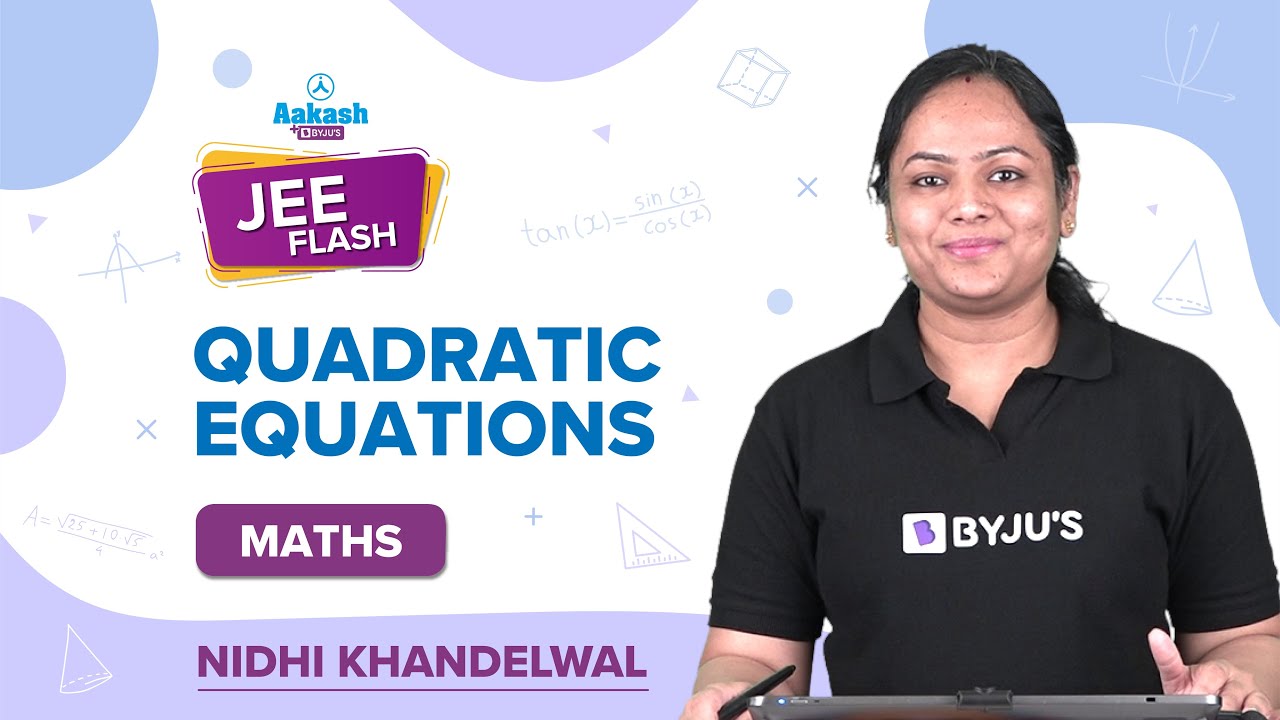What Are Algebraic Expressions and Equations?
An algebraic equation is of the form [say some variable] P = 0. On the other hand, the algebraic expression contains integer constants, variables and other mathematical tools of operation such as addition, subtraction, multiplication and division. In this section, we will discuss the quadratic expressions and equations in detail, and some algebraic expressions and equations problems covered in previous years’ IIT JEE Exams.
The parts of the algebraic expression which are separated by operations are called terms. Monomial, binomial, trinomial expressions and polynomial expressions are different types of algebraic expressions. This topic is wide and contains various concepts such as simplifying algebraic expressions, the relationship between expressions, common algebraic equations and inequalities and many more.
Important Algebraic Formulae
a2 – b2 = (a + b) (a – b)
(a + b)2 = a2 + 2ab + b2
(a – b)2 = a2 – 2ab + b2
(a + b + c)2 = a2 + b2 + c2 + 2ab + 2ac + 2bc
(a – b – c)2 = a2 + b2 + c2 – 2ab – 2ac + 2bc
(a + b)3 = a3 + 3a2b + 3ab2 + b3 or
(a + b)3 = a3 + b3 + 3ab(a + b)
(a – b)3 = a3 – 3a2b + 3ab2 – b3
a3 – b3 = (a – b)(a2 + ab + b2)
a3 + b3 = (a + b)(a2 – ab + b2)
(a + b)4 = a4 + 4a3b + 6a2b2 + 4ab3 + b4
(a – b)4 = a4 – 4a3b + 6a2b2 – 4ab3 + b4
a4 – b4 = (a – b)(a + b)(a2 + b2)
a5 – b5 = (a – b)(a4 + a3b + a2b2 + ab3 + b4)
(x + y + z)2 = x2 + y2 + z2 + 2xy + 2yz + 2xz
(x + y – z)2 = x2 + y2 + z2 + 2xy – 2yz – 2xz
(x – y + z)2 = x2 + y2 + z2 – 2xy – 2yz + 2xz
(x – y – z)2 = x2 + y2 + z2 – 2xy + 2yz – 2xz
x3 + y3 + z3 – 3xyz = (x + y + z)(x2 + y2 + z2 – xy – yz – xz)
Laws of Exponents
(am)(an) = am+n
(ab)m = ambm
(am)n = amn
Fractional Exponents
a0 = 1
am/an = am-n
1/am = a-m
Quadratic Expressions and Equations
Quadratic expressions: An expression with its degree 2 is a quadratic expression. The equation of the form ax2 + bx + c = 0 can be called a quadratic equation. Here a, b and c are constants, and a is not equal to 0. The constants a, b and c are called coefficients. A quadratic equation with one unknown is called univariate. The discriminant of a quadratic equation is D = b2 – 4ac.
The nature of roots is determined by the discriminant.
| Discriminant | Roots |
| D < 0 | The roots are unequal and imaginary |
| D = 0 | Real and equal |
| D > 0 and is a perfect square | Real, unequal and rational |
| D > 0 and not a perfect square | Real, unequal and irrational |
Related topics
Solved Examples for IIT JEE
Example 1: Find the number of real values of x for which the equality ∣3x2 + 12x + 6∣ = 5x + 16 holds good.
Solution:
Equation is |3x2 + 12x + 6|= 5x + 16 …….(i)
When 3x2 + 12x + 6 ≥ 0
⇔ x2+ 4x ≥ −2
⇔ |x + 2|2 ≥ 4 − 2
⇔ |x + 2| ≥ (√2)2
⇔ x + 2 ≤ √−2 or x + 2 ≥ √2 …….(ii)
Then, (i) becomes 3x2 + 12x + 6 = 5x + 16
⇔3x2 + 7x −10 = 0
⇒x = 1, −10 / 3
But x = −10 / 3 does not satisfy (ii).
When 3x2 + 12x + 6 < 0 ⇒ x2+ 4x < −2
|x + 2| ≤ √2 ⇒ [−√2 −2] ≤ x ≤ [−2 + √2] ? …….(iii)
Then, (i) becomes ⇒ 3x2 + 12x + 6 = −(5 x + 16)
⇒3x2 + 17x + 22 = 0
⇒x =−2,−11 / 3
But x = −11 / 3 does not satisfy (iii).
So, 1 and – 2 are the only solutions.
Example 2: What is the set of all real numbers x for which x2−|x + 2|+ x > 0?
Solution:
Case I:
When x + 2 ≥ 0 i.e. x ≥ −2, then given inequality becomes x2−|x + 2|+ x > 0
x2−2 > 0 ⇒|x| > √2
x<√−2 or x > √2
As x ≥ −2, in this case, the part of the solution set is [−2, √−2) ∪ (√2, ∞).
Case II: When x + 2 ≤ 0, i.e., x ≤ −2, then given inequality becomes x2 + (x + 2) + x > 0
⇒ x2 + 2x + 2 > 0 ⇒ (x + 1)2 + 1 > 0, which is true for all real x.
Hence, the part of the solution set in this case is (−∞, −2].
Combining the two cases, the solution set is (−∞, −2) ∪ ([−2, √−2] ∪ (√2, ∞) = (−∞, √−2) ∪ (√2, ∞).
Example 3: If the roots of the equation 8x3 − 14x2 + 7x − 1 = 0 are in GP, then find the roots.
Solution:
Let the roots be αβ, α, αβ, where β ≠ 0.
Then the product of roots is α3 = −[−1 / 8] = [1 / 8] ⇒ α = 1 / 2 and hence β = 1 / 2, so roots are 1, 1 / 2, 1 / 4
Hint: By inspection, we get the numbers 1, 1 / 2, and 1 / 4 satisfying the given equation.
Example 4: If a, b, c are real and x3 − 3b2x + 2c3 is divisible by x − a and x − b, then what is a?
Solution:
As f(x) = x3 − 3b2x + 2c3 is divisible by x − a and x − b,
Therefore, f(a) = 0 ⇒ a3 − 3b2a + 2c3 = 0 …..(i) and
f(b)=0
b3 − 3b3 + 2c3 = 0 …..(ii)
From (ii), b = c
From (i), a3 − 3ab2 +2b3 = 0 (Putting b=c) ⇒ (a−b) (a2 + ab − 2b2) = 0 ⇒ a = b or a2 + ab = 2b
Thus, a = b = c or a2 + ab = 2b2 and b = ca2 + ab = 2b2 is satisfied by a = −2b.
But b = c , a2 + ab − 2b2 and b = c is equivalent to a = −2b = −2c.
Example 5: What are the roots of the equation x4 − 2x3 + x = 380?
Solution:
Given equation is x4 − 2x3 + x = 380.
Using remainder theorem, we get (x − 5) (x + 4) (x2 − x + 19)=0
x − 5=0, x − 4 = 0 and x2 − x + 19 = 0
x = 5, x = −4 and x = [−1 ± 5√−3] / 2
Example 6: If the sum of the two roots of the equation 4x3 + 16x2 − 9x − 36 = 0 is zero, then the roots are ______________.
Solution:
Given equation 4x3 + 16x2 − 9x − 36 = 0,
Putting x = −4
[−4 × 64] + 256 + 36 − 36 = 0Hence, x = −4 is the root of the equation.
Now, reduced equation is 4x2 (x + 4) − 9 (x + 4) = 0
(x + 4) (4x2 − 9)=0
x = −4, x = ± 3 / 2
Thus, roots are −4, −3/2, 3/2.
Recommended Videos
Quadratic Equations – Flash Questions

Quadratic Equations – JEE Advanced Questions


Comments